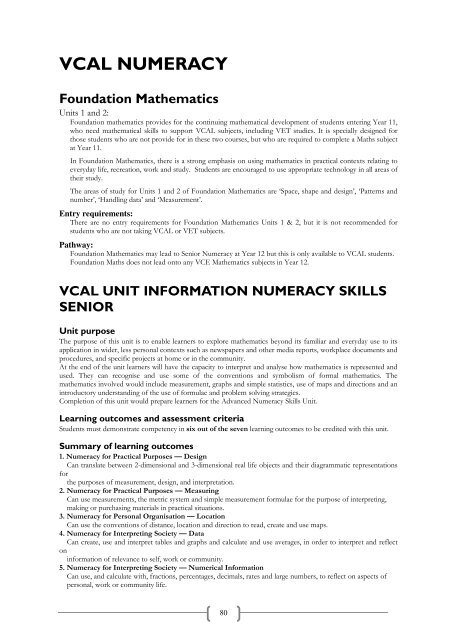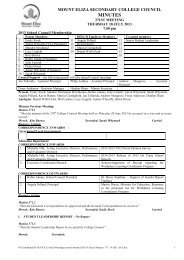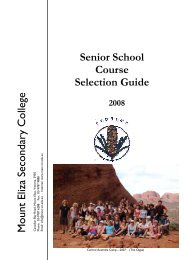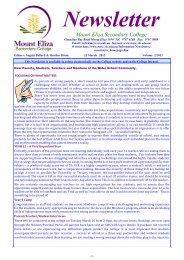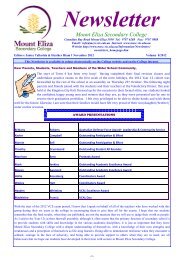9-12 Course Selection Guide - Mount Eliza Secondary College
9-12 Course Selection Guide - Mount Eliza Secondary College
9-12 Course Selection Guide - Mount Eliza Secondary College
You also want an ePaper? Increase the reach of your titles
YUMPU automatically turns print PDFs into web optimized ePapers that Google loves.
VCAL NUMERACYFoundation MathematicsUnits 1 and 2:Foundation mathematics provides for the continuing mathematical development of students entering Year 11,who need mathematical skills to support VCAL subjects, including VET studies. It is specially designed forthose students who are not provide for in these two courses, but who are required to complete a Maths subjectat Year 11.In Foundation Mathematics, there is a strong emphasis on using mathematics in practical contexts relating toeveryday life, recreation, work and study. Students are encouraged to use appropriate technology in all areas oftheir study.The areas of study for Units 1 and 2 of Foundation Mathematics are ‘Space, shape and design’, ‘Patterns andnumber’, ‘Handling data’ and ‘Measurement’.Entry requirements:There are no entry requirements for Foundation Mathematics Units 1 & 2, but it is not recommended forstudents who are not taking VCAL or VET subjects.Pathway:Foundation Mathematics may lead to Senior Numeracy at Year <strong>12</strong> but this is only available to VCAL students.Foundation Maths does not lead onto any VCE Mathematics subjects in Year <strong>12</strong>.VCAL UNIT INFORMATION NUMERACY SKILLSSENIORUnit purposeThe purpose of this unit is to enable learners to explore mathematics beyond its familiar and everyday use to itsapplication in wider, less personal contexts such as newspapers and other media reports, workplace documents andprocedures, and specific projects at home or in the community.At the end of the unit learners will have the capacity to interpret and analyse how mathematics is represented andused. They can recognise and use some of the conventions and symbolism of formal mathematics. Themathematics involved would include measurement, graphs and simple statistics, use of maps and directions and anintroductory understanding of the use of formulae and problem solving strategies.Completion of this unit would prepare learners for the Advanced Numeracy Skills Unit.Learning outcomes and assessment criteriaStudents must demonstrate competency in six out of the seven learning outcomes to be credited with this unit.Summary of learning outcomes1. Numeracy for Practical Purposes — DesignCan translate between 2-dimensional and 3-dimensional real life objects and their diagrammatic representationsforthe purposes of measurement, design, and interpretation.2. Numeracy for Practical Purposes — MeasuringCan use measurements, the metric system and simple measurement formulae for the purpose of interpreting,making or purchasing materials in practical situations.3. Numeracy for Personal Organisation — LocationCan use the conventions of distance, location and direction to read, create and use maps.4. Numeracy for Interpreting Society — DataCan create, use and interpret tables and graphs and calculate and use averages, in order to interpret and reflectoninformation of relevance to self, work or community.5. Numeracy for Interpreting Society — Numerical InformationCan use, and calculate with, fractions, percentages, decimals, rates and large numbers, to reflect on aspects ofpersonal, work or community life.80


